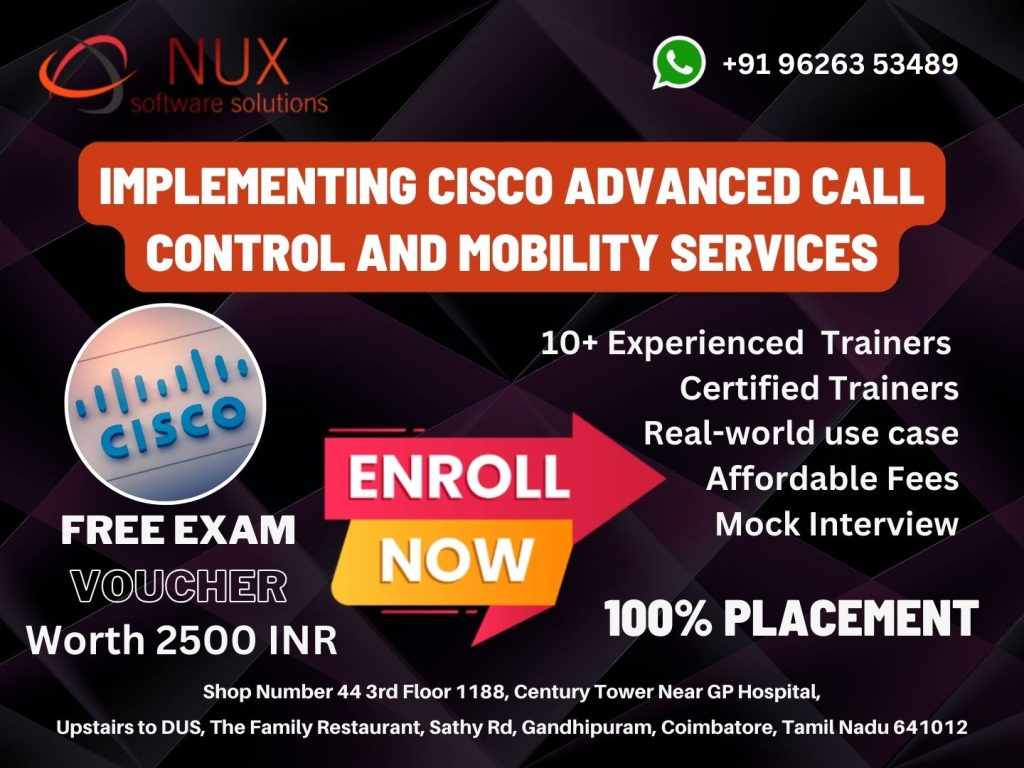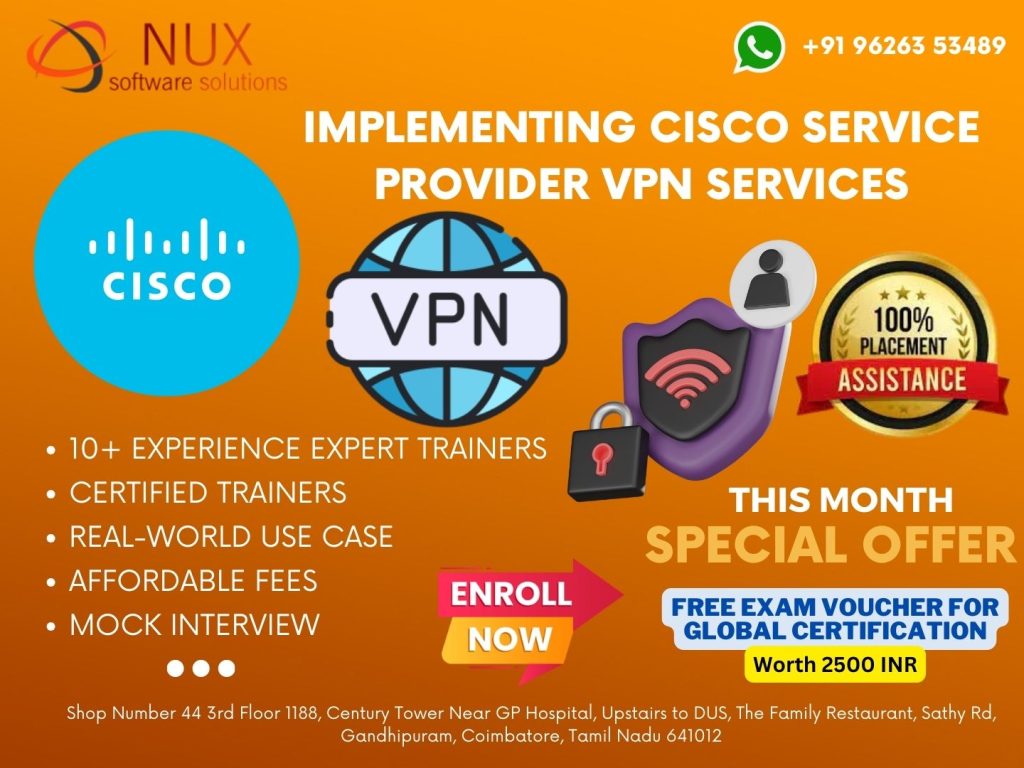Implementing and Operating Cisco Security Core Technologies 350-701 Training and Certification

Implementing Cisco ACI – DCACI 300-620 Training in Coimbatore
Course Overview
The Implementing Cisco Application Centric Infrastructure (DCACI) 300-620 course is focused on providing IT professionals with deep, hands-on knowledge of Cisco ACI (Application Centric Infrastructure). This course is ideal for network engineers, data center administrators, and professionals who are responsible for deploying and managing ACI fabrics using Cisco’s software-defined networking (SDN) solution.
At Linux Training Center, Coimbatore, our DCACI program delivers expert-led sessions, extensive lab environments, and real-world case studies to ensure participants can confidently design, implement, and troubleshoot ACI-based data center networks.
Why Learn Cisco ACI?
Cisco ACI is revolutionizing the way modern data centers are built. With centralized policy management, automation, and seamless scalability, ACI provides a unified platform for both physical and virtual networking. As more enterprises adopt SDN, ACI skills are in high demand. Learning DCACI prepares you not only for the 300-620 certification exam, but also equips you to support modern, efficient, and programmable networks.
Who Should Take This Course?
-
Network and Data Center Engineers
-
Cloud Infrastructure Professionals
-
System and Network Administrators
-
IT Consultants and Architects
-
Candidates working toward CCNP Data Center Certification
-
Anyone planning to deploy or manage Cisco ACI environments
Prior knowledge of Cisco Nexus switches, routing and switching, and data center fundamentals is recommended.
What You Will Learn
-
Core architecture and components of Cisco ACI
-
Initial ACI fabric discovery and setup using the Cisco APIC (Application Policy Infrastructure Controller)
-
Logical constructs: Tenants, Application Profiles, Endpoint Groups (EPGs), Contracts
-
Configuring policies for network access, interfaces, and fabric connectivity
-
Integration of Layer 2/3 external networks with ACI fabric
-
Understanding and implementing ACI object model and REST APIs
-
Implementing ACI access policies and bridge domains
-
Troubleshooting ACI fabric using GUI, CLI, and APIs
-
Integration with hypervisors like VMware ESXi and vCenter
-
Monitoring and managing Cisco ACI through dashboards and automation tools
Our course is lab-intensive, giving learners real-world skills through interactive labs and deployment scenarios that mirror actual enterprise use cases.
Course Benefits
-
Aligned with the DCACI 300-620 exam blueprint
-
Led by Cisco-certified trainers with practical experience
-
Fully equipped lab environment with simulated Cisco ACI fabric
-
Prepares students for advanced roles in enterprise data center networking
-
Step-by-step guidance on real-time troubleshooting and deployment
-
Delivered in both online and offline formats for flexible learning
Career Opportunities
On completing this course, students can aim for roles such as ACI Network Engineer, Data Center SDN Engineer, Infrastructure Automation Consultant, or Cisco Solutions Architect. The course also acts as a concentration exam for the CCNP Data Center certification, making it a critical step in your career progression.
Why Choose Linux Training Center in Coimbatore?
We provide industry-aligned, hands-on training that bridges the gap between theoretical certification content and real-world job responsibilities. With our ACI labs, experienced instructors, and personalized support, you’ll be fully equipped to deploy Cisco ACI solutions with confidence.
Implementing and Operating Cisco Security Core Technologies 350-701 Syllabus
Security Concepts – 25%
1. Explain common threats against on-premises and cloud environments
- On-premises: viruses, trojans, DoS/DDoS attacks, phishing, rootkits, man-in-the-middle attacks, SQL injection, cross-site scripting, malware,
Cloud: data breaches, insecure APIs, DoS/DDoS, compromised credentials
2. Compare common security vulnerabilities such as software bugs, weak and/or hardcoded passwords, SQL injection, missing encryption, buffer overflow, path traversal, cross-site scripting/forgery
3. Describe functions of the cryptography components such as hashing, encryption, PKI, SSL, IPsec, NAT-T IPv4 for IPsec, pre-shared key and certificate based authorization
4. Compare site-to-site VPN and remote access VPN deployment types such as sVTI, IPsec, Cryptomap, DMVPN, FLEXVPN including high availability considerations, and AnyConnect
5. Describe security intelligence authoring, sharing, and consumption
6. Explain the role of the endpoint in protecting humans from phishing and social engineering attacks
7. Explain North Bound and South Bound APIs in the SDN architecture
8. Explain DNAC APIs for network provisioning, optimization, monitoring, and troubleshooting
9. Interpret basic Python scripts used to call Cisco Security appliances APIs
Network Security – 20%
1. Compare network security solutions that provide intrusion prevention and firewall capabilities
2. Describe deployment models of network security solutions and architectures that provide intrusion prevention and firewall capabilities
3. Describe the components, capabilities, and benefits of NetFlow and Flexible NetFlow records
4. Configure and verify network infrastructure security methods (router, switch, wireless)
- Layer 2 methods (Network segmentation using VLANs and VRF-lite; Layer 2 and port security; DHCP snooping; Dynamic ARP inspection; storm control; PVLANs to segregate network traffic; and defenses against MAC, ARP, VLAN hopping, STP, and DHCP rogue attacks,
Device hardening of network infrastructure security devices (control plane, data plane, management plane, and routing protocol security).
5. Implement segmentation, access control policies, AVC, URL filtering, and malware protection
6. Implement management options for network security solutions such as intrusion prevention and perimeter security (Single vs. multidevice manager, in-band vs. out-of-band, CDP, DNS, SCP, SFTP, and DHCP security and risks)
7. Configure AAA for device and network access (authentication and authorization, TACACS+, RADIUS and RADIUS flows, accounting, and dACL)
8. Configure secure network management of perimeter security and infrastructure devices (secure device management, SNMPv3, views, groups, users, authentication, and encryption, secure logging, and NTP with authentication)
9. Configure and verify site-to-site VPN and remote access VPN
- Site-to-site VPN utilizing Cisco routers and IOS,
Remote access VPN using Cisco AnyConnect Secure Mobility client,
Debug commands to view IPsec tunnel establishment and troubleshooting
Securing the Cloud – 15%
1. Identify security solutions for cloud environments
- Public, private, hybrid, and community clouds,
Cloud service models: SaaS, PaaS, IaaS (NIST 800-145)
2. Compare the customer vs. provider security responsibility for the different cloud service models
- Patch management in the cloud,
Security assessment in the cloud,
Cloud-delivered security solutions such as firewall, management, proxy, security intelligence, and CASB
3. Describe the concept of DevSecOps (CI/CD pipeline, container orchestration, and security)
4. Implement application and data security in cloud environments
5. Identify security capabilities, deployment models, and policy management to secure the cloud
6. Configure cloud logging and monitoring methodologies
7. Describe application and workload security concepts
Content Security – 15%
1. Implement traffic redirection and capture methods
2. Describe web proxy identity and authentication including transparent user identification
3. Compare the components, capabilities, and benefits of local and cloud-based email and web solutions (ESA, CES, WSA)
4. Configure and verify web and email security deployment methods to protect on-premises and remote users (inbound and outbound controls and policy management)
5. Configure and verify email security features such as SPAM filtering, antimalware filtering, DLP, blacklisting, and email encryption
6. Configure and verify secure internet gateway and web security features such as blacklisting, URL filtering, malware scanning, URL categorization, web application filtering, and TLS decryption
7. Describe the components, capabilities, and benefits of Cisco Umbrella
8. Configure and verify web security controls on Cisco Umbrella (identities, URL content settings, destination lists, and reporting)
Endpoint Protection and Detection – 10%
1. Compare Endpoint Protection Platforms (EPP) and Endpoint Detection & Response (EDR) solutions
2. Explain antimalware, retrospective security, Indication of Compromise (IOC), antivirus, dynamic file analysis, and endpoint-sourced telemetry
3. Configure and verify outbreak control and quarantines to limit infection
4. Describe justifications for endpoint-based security
5. Describe the value of endpoint device management and asset inventory such as MDM
6. Describe the uses and importance of a multifactor authentication (MFA) strategy
7. Describe endpoint posture assessment solutions to ensure endpoint security
8. Explain the importance of an endpoint patching strategy
Secure Network Access, Visibility, and Enforcement – 15%
1. Describe identity management and secure network access concepts such as guest services, profiling, posture assessment and BYOD
2. Configure and verify network access device functionality such as 802.1X, MAB, WebAuth
3. Describe network access with CoA
4. Describe the benefits of device compliance and application control
5. Explain exfiltration techniques (DNS tunneling, HTTPS, email, FTP/SSH/SCP/SFTP, ICMP, Messenger, IRC, NTP)
6. Describe the benefits of network telemetry
7. Describe the components, capabilities, and benefits of these security products and solutions
- Cisco Stealthwatch,
Cisco Stealthwatch Cloud,
Cisco pxGrid,
Cisco Umbrella Investigate,
Cisco Cognitive Threat Analytics,
Cisco Encrypted Traffic Analytics,
Cisco AnyConnect Network Visibility Module (NVM)



